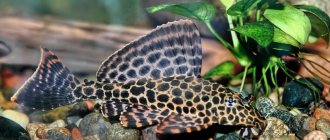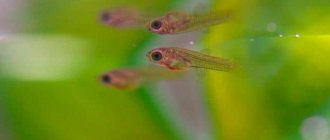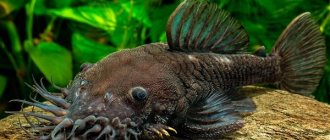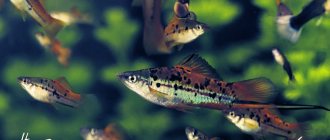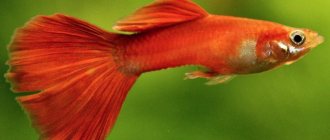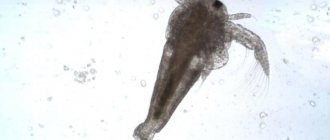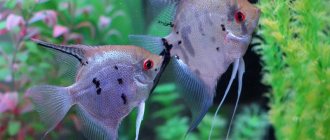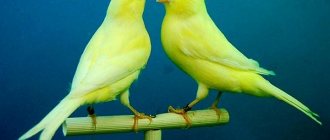The catfish family is one of the most common species of fish living in the aquarium. An individual feature of this family is the presence of bone plates instead of scales. There are approximately 800 species of catfish on the planet that live in aquariums. Among them you can find energetic and docile, predatory and herbivorous, etc.
Types of catfish
Speckled Corridor
The average length of a male is from four to six centimeters, a female is up to seven centimeters. They are olive-brown in color with many dark spots. Their belly is yellow. The sides of the body have 2 lines of bony plates, and harsh spines are located on the dorsal and pectoral fins. The front of the head is decorated with a pair of antennae.
Ancistrus
Length - up to fourteen centimeters. The color varies, starting from light gray with a yellow tint and ending with dark gray with light spots. The crown of the slightly flattened body is the voluminous head. The first rays of the fins are much thicker than the others and are equipped with spines; there are lines of bony plates on the body. There are spines hidden at the base of the head. The male is emphasized by his full “horns,” elastic skin growths on his nose. Females are a little more massive, their growths are almost smooth.
Tarakatum
The average length is from sixteen to seventeen centimeters. The male is smaller than the female. Color: coral. There are large black spots that darken over the years. The belly of females is light, that of males is coral, and during breeding it is blue. The body is oblong, with a high dorsal crest, a flat belly and a thickened base of the tail. The lower part of the wide head is flat. There are 3 pairs of short antennae.
Pterygoplicht brocade
Length - up to twenty centimeters. The coloring echoes the leopard pattern: brown-black spots bordered with yellow are located on the body. Over the years, the picture becomes smaller and may disappear completely. The body is flattened and long. The scales are made up of bone plates. With a high dorsal fin, full pectoral and ventral fins.
Synodontis
The average length is from six to nine and a half centimeters.
The female is larger than the male. Gray-beige color with black-brown spots, belly slightly darker. With a stocky, slightly flattened body at the sides. The caudal fin has 2 blades and a triangular dorsal fin. Synodontis has large eyes and 6 antennae in the mouth area. We also recommend reading:
The largest dog breeds What is domestication in animal husbandry Why you should get a cat: reasons voiced by scientists Euthanasia of animals
White-spotted agamixis
Length - up to twelve centimeters. The female is more massive and duller. With brown-black color. Has pale yellow spots. The body is large and long. There are bone plates and spines. The head is large, flattened, with 3 pairs of speckled mustaches. The dorsal fin is triangular in shape. It has a tooth on the front ray, small and rounded ventral fins. The female has a remarkably large, unshaped belly.
Callicht
Size - up to fifteen centimeters. Coloring ranges from olive green to dark gray with large dark spots. In males, the anterior ray in the pectoral fin is notable for its orange color. The body is long, slightly flattened on the sides, on which there are 2 lines of bone plates; not the entire back is covered with them. The flattened upper part is voluminous with 3 pairs of antennae in the mouth area of the head.
Brohis
The average size is from eight to nine centimeters. The female is larger and has a more rounded belly. Brochis has a greenish color with a cast of sides, a brownish back and a bright yellow belly. These fish have a large head and a long body, which elastically smoothly descends towards the tail cover. On the flat sides there are 2 lines of strong plates and a two-lobed tail cover.
Catfish anchor
Length - up to three and a half centimeters. The female is longer and more massive. Coloring ranges from reddish-brown to dark brown with dark spots and stripes. The upper part of the body is curved, the size of the pectoral fins is proportionally long, and there are tubercles on the skin.
Interesting fact. The river catfish is distinguished by its extraordinary cunning. He hunts without moving. To lure prey, the catfish copies the worms with elastic movements of its antennae. At the moment when the victim is at a close distance from the catfish, it quickly sucks in water along with the victim.
Types of aquarium catfish with names and descriptions
Aquarium catfish photo
Despite the fact that these fish are very popular, only some types of aquarium catfish are found in home aquariums, and the rest can only be seen by professionals with many years of experience.
Let's consider the varieties of aquarium catfish that are found among enthusiastic amateur aquarists:
- Antennae or pimelod catfish. It got its name thanks to its 6 antennae (4 of them on the chin). In nature, they live in fast rivers, so in captivity they are demanding about filtering water and saturating it with oxygen. Without suckers, they lead an active lifestyle. Moreover, among them there are both small ones (up to 5 cm long) and respectable individuals (up to 60 cm), which are kept in the aquarium only up to a certain age. Particularly interesting among them is the rough flathead, which loves to swim upside down, so don’t be scared, this is the normal behavior of this pet.
- Agamixis. Very peaceful creatures no more than 10 cm long. During the day they hide in shelters, and at night they come out to dig into the bottom contents, so to prevent the fish from reminding itself of itself with clouds of turbidity, it is better to place it in a flask with coarse-grained soil. Most often in home aquariums you can find Agamixis whitespotted.
- Pterygoplichts. Popular cleaner catfish are mostly large. They live only in large containers and only a few individuals at a time, otherwise they get bored. They feed mainly on plant food, but when there is a shortage of it, they show aggression towards smaller neighbors or eat plants. They lead a twilight lifestyle and are in dire need of shelter and thickets. Among all the others, Pterygoplichtas brocade is the most commonly found species in the aquarium.
- Ancistrus. A very common genus of the chain catfish family, which has up to 30 species. Among amateurs, these fish are often called sucker catfish or sticky ones. Being no more than 10 cm long, these herbivorous inhabitants willingly feast on scalded leaves of spinach, cabbage, lettuce, pieces of cucumber or pumpkin, and can gnaw on driftwood used for decorative purposes.
- Corridors. They belong to the chainmail (armored) catfish and have 3 pairs of antennae. The most famous is the corydoras panda, a yellowish or pinkish-orange catfish with dark spots on its dorsal fin. A distinctive feature of the fish is its black mask, making it look like a bear, from which its name comes.
- Loricaria. They also belong to the chain catfish and grow up to 12 cm long. Their males are much slimmer than females and have a characteristic fleecy brush on their chest. Frequent inhabitants of aquariums are red loricaria and Peruvian loricaria, which have a chocolate color.
Determination of gender
The main sexual differences appear in the 8th month of life. They become completely obvious around the age of one year, at the end of puberty. As a result, males are smaller in size, have a more beautiful body structure and are brighter in color compared to females.
Another characteristic difference is the thickness and shape of the belly. Males tend to be fitter. The belly is flattened. In addition, the dorsal fins of males are much higher, and the caudal fins are noticeably wider. Females have less prominent antennae with skin growths on the head.
From observing fish, we can conclude that they differ in their behavior. While males sometimes display aggressive behavior and even engage in fights, females are usually calmer.
Proper arrangement of an aquarium for breeding
As a rule, there are no difficulties with breeding catfish; they can do this even in a common aquarium, if there are fish of the same species in it.
If fish of different species live there, then you should prepare a separate container - a spawning tank - the volume of which is 30-50 liters. It is advisable that it be with soft soil, snags, stones and a large number of plants.
These fish are much more comfortable with shelters in which they can retire and relax.
However, catfish are distinguished by their unpretentiousness, thanks to which some aquarists quite successfully manage to breed them in spawning grounds without soil and vegetation.
But in order to stimulate spawning, it would be more correct to create the following conditions in the aquarium:
- water must be clean, neutral, not acidic;
- the temperature should be from +17 to –25 °C;
- it is necessary that ventilation be enhanced;
- lighting should be natural and moderate.
As a rule, artificial plants are located in the spawning area. Living algae must have a strong root system.
Conditions of detention
Corydoras are bottom fish. When arranging the tank, it is necessary to take this nuance into account.
Arrangement of the aquarium
The owner of the corydoras should create a special soil structure where the catfish will swarm. Cover the upper part of the bottom with sand. Fine and smooth gravel will also work.
Along with the aquarium, you must purchase a filter and an aerator.
Water and lighting
Parameters of water in the tank:
- temperature – 22–26 °C;
- optimal acidity 5.8–7.6 pH;
- hardness 6–17 dH.
It is necessary to change 1/4 of the water in the aquarium weekly. Clean the bottom twice a month using a siphon. The soil should not contain sharp pebbles or broken parts from decorative decorations. All these objects can injure the fish’s body.
It is recommended to use not too bright lamps for lighting. Create shading in the tank that does not irritate the fish and also promotes their reproduction. This can be done with the help of floating plants.
Plants and decorations
Plants must have a strong root so that the catfish does not undermine it.
Use:
- mosses;
- fern;
- bushes.
Vegetation should not be planted too densely. The fish will need free space to easily pick up food from the bottom. Also, catfish should have free access to the surface of the water.
The tank will be decorated with decorative elements. For example, driftwood and caves. When installing them, you should leave enough space on the bottom for the aquarium fish to poke around.
Aquarium decor items should not release toxic substances into the water!
How does the mating process occur?
For reproduction, a sexually mature pair of fish is needed, however, according to the recommendations of many breeders, there should be several females per male. The incentive to start spawning is a protein diet. During this period, the fish must be given live or frozen bloodworms, brine shrimp, daphnia, and tubifex.
Important! Catfish can eat their own eggs; therefore, 2 separate aquariums should be provided for spawning and raising offspring.
Corydoras Spawning
As a rule, spawning begins in the early morning. The male pushes the female with his antennae, tickling her back and sides. Then it turns at right angles to the female’s head and releases the seed.
Experts cannot definitively agree on how eggs are conceived. Some suggest that the female, passing the seed through the intestinal tract, releases it onto the eggs located in the ventral fins. Another part believes this: the seed passes only past the female’s gills, and is sent along the longitudinal direction of the body to the egg.
When conception is complete, the female glues the egg onto a previously cleaned surface. Immediately after the eggs are laid, the mating process is resumed until all two hundred to three hundred eggs have been fertilized. This may take an hour or more. As a result, to breed corydoras, it is only necessary to provide them with proper living conditions.
How to care for caviar
After spawning is completed, the couple should be moved to another container. Temperature affects how the eggs will mature - the warmer the water, the sooner the fry will hatch. On average, it takes eight to twelve days for the eggs to mature.
For the fruitful development of the fry, you should maintain the temperature from +19 to +21 ° C, change part of the water from time to time, leave only natural lighting or slightly shade the aquarium from light.
Important! There may be slight differences in the conditions for breeding catfish, depending on the species; therefore, before purchasing them, you need to familiarize yourself with the characteristics of this species and consult with specialists.
Compatibility of aquarium catfish with other fish
The ability to get along with other species of fish is the determining criterion when purchasing new pets. As a completely peaceful fish, the aquarium catfish in this regard compares favorably with other species. Almost every catfish is indifferent to its neighbors, gets along calmly with them, and does not notice some, especially those living in the upper water layers, at all.
However, we should not forget that among the representatives of the species there are also predators who do not mind inviting their neighbor to dinner. Thus, the rough flathead can easily get along with large, non-aggressive stingrays or angelfish, but smaller fish, to the surprise of the owner, may disappear.
But the catfish themselves can become victims of intra-aquarium struggle. Small ancistrus should not be housed with their natural enemies, such as aggressive cichlids that will eat their fins.
Caring for fry
As soon as the fry have appeared, they are first fed with the yolk sac of the eggs. Then their further food turns out to be ciliates and special dry food for fry or regular food, but crushed into powder form.
After one to one and a half weeks, larger amounts of live food can be included in the diet.
Now you have learned that breeding catfish is not that difficult. This is also feasible for amateur aquarists. Provide your fish with good conditions for fertilization, a complete diet, and nature will take care of the rest.
Nutrition issues
The diet of catfish is significantly different from that of most aquarium fish. When choosing food and regimen, take into account the individual characteristics of a particular species.
What does catfish eat?
Most catfish are omnivores, but there are species among them that prefer animal or plant food. A variety of foods are used to feed them - dry, frozen, freeze-dried. An optimal diet should contain plant and animal foods.
It is recommended to feed catfish:
- raw fish;
- shrimp and other seafood;
- herbs and vegetables;
- flakes and tableted catfish feed.
If there are other fish in the aquarium besides catfish, you don’t have to feed the catfish specially. They pick up leftover food that sinks to the bottom, and at the same time clean the aquarium.
Feeding frequency
Catfish fry are fed 2-3 times a day plus feeding at night. For adult predatory catfish, a single meal is enough. Food is given in anticipation of the night, turning off the lights. Herbivorous catfish have to be fed more often - 3-4 times a day.

